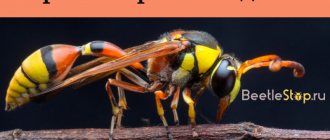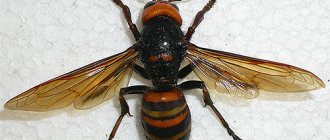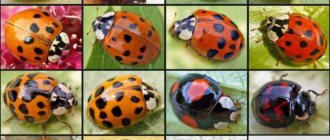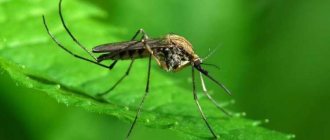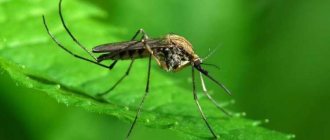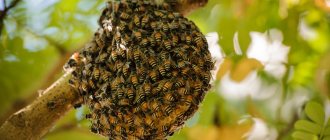Bees appeared as a result of natural and artificial selection, which people began during the development of beekeeping and beekeeping. Because of their honey, these insects are the most useful on the farm. Ancient people specially bred bees, and honey was used not only for food, but also as medicine. Bees live in different parts of the planet and are distinguished by their external characteristics, stability, productivity and other qualities.
Description and features
The bee belongs to the superfamily of stinging flying insects Apoidea. It is closest to wasps and ants. There are approximately 21,000 species and 520 genera of bees worldwide.
Bee close up
Insects feed on pollen and nectar. At the same time, pollen serves as a source of useful substances for them (in particular protein), and nectar serves as energy. Some species have the highest social organization.
Bees can have different appearances depending on the specific species. But on average they are about 3 centimeters in size and striped in color, alternating yellow-orange and black. The body is completely covered with hairs, which serve as protection and function as organs of touch.
A distinctive feature of the bee is the presence of a proboscis for sucking nectar and sensing taste. And the antennae are responsible for the sense of smell, recognizing heat/cold/humidity. Some parts of the body and legs act as hearing organs.
Varieties
The Karnika bee breed has several varieties, which are characterized by some distinctive features: character, behavior, productivity, and breeding characteristics.
Pawn
This is the oldest strain of the breed. Insects are able to take bribes from any honey plants and simultaneously work with several types of plants. They are very calm, assiduous and peaceful. Development begins very early and does not stop until October. The peak of development occurs in May.
Bees live in large families, which allows them to effectively use more than 2-3 bribes per season. They are characterized by a very high degree of swarming. But it is easily corrected with special means. If honey is collected in time, swarms will not form.
With purebred breeding, the pawn retains all its inherent properties. Hybrids inherit characteristic characteristics in the first two generations.
Sklenar
Insects have rare perseverance, but are capable of showing aggression. Development is gradual, most effective for collecting nectar from late honey plants. They work great even in September. They create large and medium-sized bee colonies. Swarms form extremely rarely.
Genetic properties are stable only when breeding purebred insects. Already in the first generation of hybrids, a splitting of characteristics is observed.
Troyzek
A distinctive feature is the intensive development of the offspring, which is observed in the spring, but only in the presence of pollen. If there is no pollen, the queen bee may stop scarring. Insects are very clean and hardworking, and are not prone to forming swarms.
The strain is genetically unstable. During hybridization, the original qualities are completely lost.
Structure, what a bee looks like
External structure of a bee
A bee belongs to the category of arthropods. Her body consists of three main parts:
- heads;
- chest part;
- abdomen
Another distinctive feature of insects is the exoskeleton, which is presented in the form of a protective hard shell. Muscles and internal organs are attached to it.
The bee's head is protected by a layer of chitin. In addition to antennae, she has an upper lip and mouthparts with well-developed muscles. This allows insects to carry small objects and bite through any natural materials.
The thoracic part consists of several sections.
Here are the muscles with which the bee controls its wings. She also has three pairs of legs. The hind legs are most covered with hairs that carry pollen. Insects use their front legs for personal hygiene. Interesting fact : bees can reach speeds of up to 60 km/h, while making approximately 400 wing beats per second.
If an insect flies not “light”, but with some kind of cargo, then its maximum speed is up to 20 km/h. The heaviest weight tolerated is up to 75 mg. Almost all internal organs are concentrated in the abdomen. It consists of several segments that are connected by an elastic film. On the abdomen there are special glands (4 pairs) that secrete wax.
The most important organ of a bee is the sting. She uses it for defense, but if lost, the insect's lifespan is reduced to a couple of hours. The fact is that the sting is very sharp and has serrations, unlike the wasp. Having attacked the enemy, the bee tries to pull him out and thereby damages its organs.
Bee sting
Lifestyle and habitat
The favorite habitats of wild bees are mountain crevices, earthen holes, and hollows of old trees. Bees choose areas that are located near water bodies and are also reliably protected from difficult weather conditions and wind.
Bee's nest
In mild climates, nests are built high in trees. Having chosen a suitable place to live, they begin to build honeycombs from hexagonal-shaped cells. Each cell has thin walls. The honeycombs are mounted vertically and have an elongated shape. Special frames are adapted for domestic bees, and wild insects build honeycombs on their own.
Before the onset of cold weather, the main task of bees is to stock up on provisions and insulate their homes. They do this with the help of propolis, which covers all the cracks. Then the insects move to the lower part of the nest, where they stay together, periodically changing places.
Honeycomb
Interesting fact : comfortable temperature for bees is 25-36℃. In winter, inside the nest they maintain a temperature of about 13℃.
In general, wild bees differ from domestic ones only in certain behavioral and character traits. For example, they are more aggressive because they have more natural enemies and are forced to protect their reserves. They are also hardier, more resistant to cold and disease.
Interesting: Spiders
